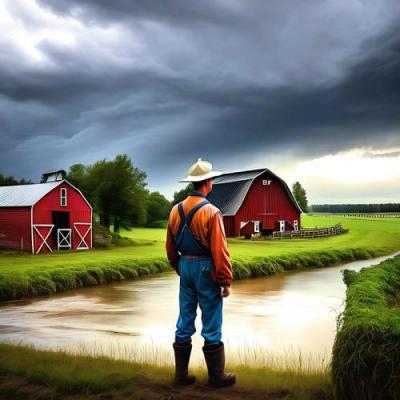Understanding the Risks
To develop a comprehensive disaster response plan, it's important to understand the risks that you may face. While the location of your farm is a significant factor, other factors can also contribute to risks that should be considered when creating a disaster response plan.
One factor to consider is the age and condition of your buildings and equipment. Old or poorly maintained buildings and equipment can be at risk of collapsing or causing fires, which could lead to significant damage to your property and assets.
Another factor is the type of farming operations you have. For example, if you have a large dairy operation, the loss of power or equipment failure could have a significant impact on your ability to care for your animals and maintain milk production. Similarly, if you grow crops that require irrigation, a drought or loss of water supply could have a significant impact on your harvest.
In addition to these factors, weather-related risks can also occur regardless of location. For example, even if your farm is not located in a flood zone, heavy rainfall or a severe storm could still cause flooding on your property. Similarly, while bushfires are more prevalent in certain areas, they can occur anywhere and pose a significant risk to farms and rural communities.
By identifying all potential risks that your farm may face, you can develop a comprehensive disaster response plan that takes into account all possible scenarios. This will help you to be better prepared for any emergency and minimize the impact on your property, assets, and loved ones.
So, when developing a disaster response plan, it's important to not only consider the location of your farm but also other factors that may contribute to risks, such as the age and condition of buildings and equipment, type of farming operations, and weather-related risks. By taking a comprehensive approach to risk assessment, you can be better prepared for any emergency and protect your farm and livelihood.
Building Your Disaster Response Team
One of the most critical aspects of developing a comprehensive disaster response plan is building a strong team to assist you in the event of an emergency. As an Australian farmer, your disaster response team should include key members of your family, employees, and neighbors who can provide assistance and support during a disaster.
It's important to define the roles and responsibilities of each team member to ensure that everyone knows what to do in the event of an emergency. For example, someone should be responsible for evacuating the property, while others may be responsible for securing equipment or moving livestock to safety. Make sure everyone on your team understands their roles and responsibilities and is aware of the potential risks they may face.
In addition to your immediate team members, it's also important to build relationships with external stakeholders, such as emergency services, suppliers, and neighboring farmers. Developing these relationships can help you to access resources and support in the event of an emergency. In Australia, there are several organizations and agencies that provide assistance during disasters, such as the Rural Fire Service, the State Emergency Service, and the Department of Agriculture and Water Resources.
One example of building a strong disaster response team in Australia is the Rural Resilience Program, which is part of the Australian Government's $4 billion investment in drought and natural disaster support. The program provides resources and support to farmers and rural communities to help them better prepare for and respond to disasters.
Another example is the Australian Red Cross, which provides emergency assistance during disasters, including food, shelter, and emotional support. The organization also offers a program called "Get Prepared", which provides resources and information to help individuals and communities prepare for emergencies and disasters.
Building a strong disaster response team is critical to protecting your property, assets, and loved ones during an emergency as an Australian farmer. Define the roles and responsibilities of each team member, build relationships with external stakeholders, and learn from examples such as the Rural Resilience Program and the Australian Red Cross to develop a strong and effective disaster response team. By working together and being prepared, you can minimize the impact of disasters and protect your farm and livelihood.
Assessing Your Risks
To develop a comprehensive disaster response plan, you need to conduct a thorough assessment of the risks that your farm may face. This involves identifying potential hazards and risks, such as natural disasters, equipment failure, or animal disease outbreaks, and developing a plan to mitigate them.
One example of assessing risks and developing a plan is the Farm Risk Management Plan, a program offered by the Australian government. The program provides farmers with tools and resources to assess the risks they face and develop a plan to manage them. This includes identifying risks related to production, finance, and natural disasters, as well as developing strategies to mitigate those risks.
Another example is the Farm Hazards program, which is also offered by the Australian government. The program helps farmers to identify hazards and risks associated with their farming operations, such as electrical hazards or chemical exposures. The program provides resources and tools to manage those hazards and minimize the risk of injury or property damage.
Assessing your risks also involves conducting an inventory of your property and assets, including livestock, crops, and equipment. This inventory will be important for insurance purposes in the event of a disaster. You should also consider the potential impact of a disaster on your business, such as lost income, additional expenses, or damage to your reputation.
It's important to keep your risk assessment up to date and review it regularly. As your farm and operations change, your risks may also change, and your disaster response plan should be updated accordingly.
Assessing your risks is a critical step in developing a comprehensive disaster response plan for your farm. Look to examples such as the Farm Risk Management Plan and the Farm Hazards program for guidance on how to assess risks and develop a plan to manage them. By understanding the potential risks you may face and developing strategies to mitigate them, you can be better prepared for any emergency and protect your property, assets, and loved ones.
Creating Your Disaster Response Plan
Once you've identified potential risks and built a strong disaster response team, the next step is to create a plan for responding to disasters. Your disaster response plan should outline the steps to take in the event of a disaster, including evacuation procedures, asset protection strategies, and recovery and restoration plans.
One example of creating a disaster response plan is the Western Australian Government's Emergency Management Plan. The plan provides a comprehensive framework for responding to emergencies, including natural disasters, pandemics, and other crises. The plan outlines roles and responsibilities, communication protocols, and recovery strategies, and is regularly reviewed and updated.
Another example is the Australian Government's National Disaster Risk Reduction Framework, which provides a national approach to disaster risk reduction. The framework includes strategies to identify and manage risks, promote community resilience, and improve emergency response capabilities.
Your disaster response plan should also include important contact information, such as emergency services, veterinarians, and suppliers, and be easily accessible to all members of your team. You should conduct regular training sessions and drills to ensure everyone understands the plan and knows what to do in the event of an emergency.
It's also important to consider the financial implications of a disaster and ensure that you have adequate insurance coverage. Your disaster response plan should include a review of your insurance coverage, including policies for property damage, crop loss, and liability. You should also consider whether additional coverage, such as business interruption insurance, is necessary.
In summary, creating a comprehensive disaster response plan is critical to protecting your property, assets, and loved ones during an emergency. Look to examples such as the Western Australian Government's Emergency Management Plan and the National Disaster Risk Reduction Framework for guidance on creating a plan. By including important contact information, conducting regular training, and reviewing your insurance coverage, you can be better prepared for any emergency and minimize the impact on your farm and livelihood.
Communicating Your Plan
Communicating your disaster response plan is critical to ensure that everyone on your team knows what to do in the event of an emergency. Your plan should be easy to understand and accessible to all members of your team, including employees, family members, and neighboring farmers.
One example of effective communication is the Rural Fire Service's (RFS) Get Ready program. The program provides resources and information to help individuals and communities prepare for emergencies and disasters. The RFS encourages individuals to create a survival plan, prepare an emergency kit, and stay informed about potential risks and emergencies.
Another example is the Australian Red Cross's Emergency REDiPlan. The plan is a step-by-step guide to help individuals and families prepare for emergencies, including natural disasters, power outages, and health emergencies. The plan provides guidance on developing a household emergency plan, preparing an emergency kit, and staying informed during emergencies.
When communicating your plan, it's important to consider different communication channels, such as phone, email, and social media. You should also establish a communication plan for during and after the emergency, including a system for checking in with team members and updating them on the situation.
In addition to communicating with your disaster response team, it's also important to communicate with external stakeholders, such as emergency services, suppliers, and customers. This can help you to access resources and support during an emergency and minimize the impact on your business.
In summary, effective communication is critical to ensure that your disaster response plan is understood and accessible to all members of your team. Look to examples such as the Rural Fire Service's Get Ready program and the Australian Red Cross's Emergency REDiPlan for guidance on effective communication. By considering different communication channels and establishing a communication plan, you can be better prepared for any emergency and protect your farm and livelihood.
Conclusion
Developing a comprehensive disaster response plan for your farm is a critical step in protecting your property, assets, and loved ones. By understanding the risks, building your disaster response team, assessing your risks, creating your disaster response plan, and communicating your plan to all stakeholders, you can be better prepared for any emergency.
Here are some links that you may find helpful.
- Australian Red Cross's Emergency REDiPlan
- FarmHub, a national directory of farming resources
- Emergency NSW, a government website with information on emergency services and disaster relief
Don't wait until it's too late. Take action and start planning for the worst today. Remember, it's better to be overprepared than caught out!
Published: Friday 31st March, 2023
Last updated: Monday 10th March, 2025









